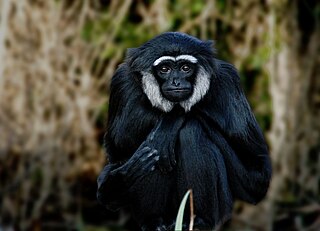 W
WThe agile gibbon, also known as the black-handed gibbon, is an Old World primate in the gibbon family. It is found in Indonesia on the island of Sumatra, Malaysia, and southern Thailand. The species is listed as endangered on the IUCN Red List due to habitat destruction and the pet trade.
 W
WMüller's gibbon ,, also known as the grey gibbon, is a primate in the gibbon family, Hylobatidae.
 W
WKloss's gibbon, also known as the Mentawai gibbon or the bilou, is an endangered primate in the gibbon family, Hylobatidae. It is identifiable in that it is all black, resembling the siamang with its black fur, but is considerably smaller and lacks the siamang's distinctive throat pouch. Kloss's gibbon reaches a size 17 to 25 inches and weigh at most 13 pounds (6 kg). As is the case for all gibbons, they have long arms and no tail.
 W
WThe silvery gibbon is a primate in the gibbon family Hylobatidae. It is endemic to the Indonesian island of Java, where it inhabits undisturbed rainforests up to an altitude of 2,450 m (8,040 ft). It is listed as Endangered on the IUCN Red List since 2008, as the wild population is estimated at comprising less than 2500 mature individuals.
 W
WThe Bornean white-bearded gibbon,, also known as the Bornean agile gibbon or southern gibbon, is a species of gibbon endemic to southern Borneo. It is an endangered species, due to the undergoing logging of the tropical forests, between the Kapuas and Barito rivers. Additional issues are of concern to the endangerment of white-bearded gibbons and threatening to other arboreal primates.
 W
WHose's langur is a species of primate in the family Cercopithecidae endemic to the island of Borneo, including Brunei, Kalimantan (Indonesia), and East Malaysia. Its natural habitat is subtropical or tropical dry forests. It is threatened by habitat loss. It was first identified in Kutai National Park and Sangkulirang Peninsula, East Kalimantan, Indonesia, in 1985.
 W
WThe Mentawai langur is a species of primate in the family Cercopithecidae. It is endemic to the Mentawai Islands in Indonesia.
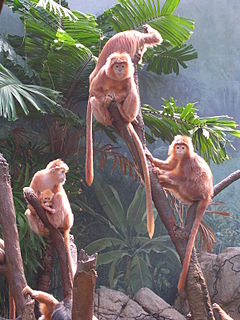 W
WThe East Javan langur, also known as the ebony lutung, Javan langur or Javan lutung, is an Old World monkey from the Colobinae subfamily. It is most commonly glossy black with a brownish tinge to its legs, sides, and "sideburns". It is found on the island of Java, as well as on several of the surrounding Indonesian islands. The Latin word auratus in its scientific name means "golden", and refers to a less common color variant. Note that the common name golden langur is used for a different species.
 W
WThe Thomas's langur is a species of primate in the family Cercopithecidae. It is endemic to northern Sumatra, Indonesia. Its natural habitat is subtropical or tropical dry forests. It is threatened by habitat loss. Its native names are reungkah in Acehnese and kedih in Alas.
 W
WThe Tonkean black macaque or Tonkean macaque is a species of primate in the family Cercopithecidae. It is endemic to central Sulawesi and the nearby Togian Islands in Indonesia. It is threatened by habitat loss. Widespread mining in central Sulawesi is believed to exacerbating the problems of habitat loss.
 W
WThe booted macaque is a macaque of the Sulawesi Island, Indonesia. This Old World monkey is diurnal and spends most of the day in the trees. It is 50–59 cm long plus a tail of 35–40 cm.
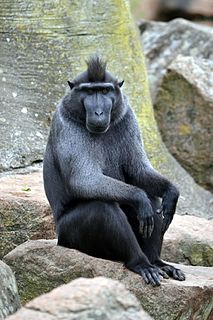 W
WThe Celebes crested macaque, also known as the crested black macaque, Sulawesi crested macaque, or the black ape, is an Old World monkey that lives in the Tangkoko reserve in the northeastern tip of the Indonesian island of Sulawesi (Celebes), as well as on smaller neighboring islands.
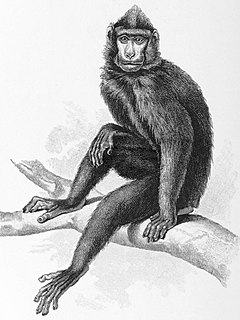 W
WThe Gorontalo macaque or Dumoga-bone macaque is a species of primate in the family Cercopithecidae. It is endemic to the island of Sulawesi in Indonesia.
 W
WThe Heck's macaque is a macaque of Sulawesi, Indonesia. This Old World monkey is diurnal.
 W
WThe moor macaque is a macaque with brown/black body fur with a pale rump patch and pink bare skin on the rump. It is about 50–58.5 cm long, and eats figs, bamboo seeds, buds, sprouts, invertebrates and cereals in tropical rainforests. It is sometimes called "dog-ape" because of its dog-like muzzle, although it is no more closely related to apes than any other Old World monkey is. It is endemic to the island of Sulawesi in Indonesia.
 W
WThe Pagai Island macaque, also known as the Pagai macaque or Bokkoi, is an Old World monkey endemic to the Mentawai Islands off the west coast of Sumatra. It is listed as critically endangered on the IUCN Red List due to its ever-shrinking habitat. Macaca pagensis formerly included the overall darker Siberut macaque as a subspecies, but this arrangement is polyphyletic, leading to the two being classified as separate species. Both were formerly considered subspecies of the southern pig-tailed macaque.
 W
WThe Siberut macaque is a vulnerable species of macaque, which is endemic to Siberut Island in Indonesia. It was formerly considered conspecific with the Pagai Island macaque which is overall paler in color, but this arrangement was polyphyletic. Both were formerly considered subspecies of the southern pig-tailed macaque.
 W
WThe Makassar tarsier is a species of tarsier. Its range is in Indonesia in the southwestern peninsula of the island of Sulawesi, near Makassar. At one point the taxon was downgraded to a junior synonym of the spectral tarsier. However, when that species' range was restricted to the population on a single island near Sulawesi, this nomen was resurrected to contain the remainder of that species.
 W
WMiller's langur, also known as Miller's grizzled langur or Kutai grey langur, is a species of leaf monkey. It is endemic to the island of Borneo. It is one of the world's most endangered primates and was at one time thought to be extinct until it was rediscovered in 2012.
 W
WThe maroon langur, maroon leaf monkey, or red leaf monkey is a member of the family Cercopithecidae. It is found on the southeast Asian island of Borneo and the nearby smaller Karimata. P. rubicunda mostly live in forests at altitudes below 2,000 m. They feed on leaves (36%),.
 W
WOrangutans are great apes native to Indonesia and Malaysia. They are found in the rainforests of Borneo and Sumatra, but during the Pleistocene they ranged throughout Southeast Asia and South China. Classified in the genus Pongo, orangutans were originally considered to be one species. From 1996, they were divided into two species: the Bornean orangutan and the Sumatran orangutan. In 2017, a third species, the Tapanuli orangutan, was identified. The orangutans are the only surviving species of the subfamily Ponginae, who split from humans, chimpanzees and gorillas 19.3 to 15.7 million years ago (mya).
 W
WThe Saban grizzled langur, also known as the Sabah grizzled langur, is a species of monkey in the family Cercopithecidae. It was formerly considered a subspecies of Hose's langur, Presbytis hosei. The Saban grizzled langur is native to the island of Borneo in the province of Sabah in Malaysia, with part of its range in Indonesia. It is listed as endangered by the IUCN due primarily to habitat loss, fragmentation and hunting.
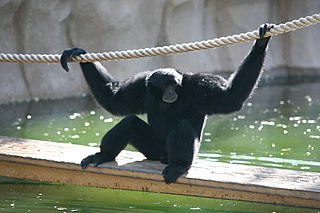 W
WThe siamang is an arboreal, black-furred gibbon native to the forests of Indonesia, Malaysia, and Thailand. The largest of the gibbons, the siamang can be twice the size of other gibbons, reaching 1 m (3.3 ft) in height, and weighing up to 14 kg (31 lb). The siamang is the only species in the genus Symphalangus.
 W
WThe Javan surili is an endangered species of Old World monkey endemic to the western half of Java, Indonesia, a biodiversity hotspot. Other common names by which it is known by include gray, grizzled or Sunda Island surili; grizzled or stripe-crested langur; Javan grizzled langur; grizzled, Java or Javan leaf monkey; langur gris.
 W
WThe Natuna Island surili is a species of primate in the family Cercopithecidae.
 W
WThe Sarawak surili is a species of primate in the family Cercopithecidae. It is endemic to the southeast Asian island of Borneo, where it is distributed north of the Kapuas River in Kalimantan, Indonesia, the Malaysia states of Sarawak and Sabah, and in Brunei. Its taxonomy is complex and disputed, and it has been considered a subspecies of P. femoralis or P. melalophos. The Sarawak surili was formerly considered common, but has declined drastically due to persecution and habitat loss, and as of 2008 is only known from five sites with a combined population of 200–500 individuals. Consequently, it is believed to be one of the rarest primates in the world, and has been rated as critically endangered by IUCN.
 W
WThe black-crested Sumatran langur is a species of primate in the family Cercopithecidae. It is endemic to Sumatra in Indonesia. Its natural habitat is subtropical or tropical dry forests. It is threatened by habitat loss.
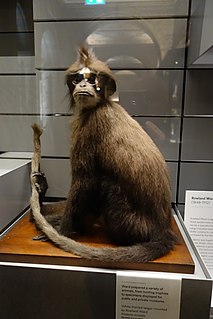 W
WThe white-fronted surili is a species of primate in the family Cercopithecidae. It is endemic to the large international island of Borneo, in Indonesia, Malaysia, and possibly Brunei.
 W
WThe white-thighed surili is a species of primate from the family of old world monkeys (Cercopithecidae). This species lives arboreal amongst the sub-montane forests. It is endemic to the Thai-Malay Peninsula, the Riau Archipelago and Sumatra. In addition, the white-thighed surili contain four subspecies: siamensis (nominate), cana, paenulata and rhionis, are recognized here. Furthermore, they are characterized by the white patches located on the outside of their legs, which is what gives them their name. Additionally, they can be referred to as pale-thighed langur/surili. These primates are important an important species for the diversity of forest environments in the Malaysian area.
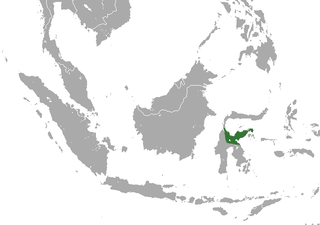 W
WDian's tarsier, also known as the Diana tarsier, is a nocturnal primate endemic to central Sulawesi, Indonesia. Its head-body length is 11.5–12 centimetres (4.5–4.7 in) and it has a tail of 22 centimetres (8.7 in). Dian's tarsier lives in rainforests. It was formerly called T. dianae, but that has been shown to be a junior synonym.
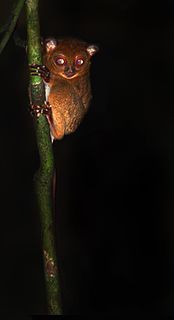 W
WHorsfield's tarsier, also known as the western tarsier, is the only species of tarsier in the genus Cephalopachus. It occurs on Borneo, Sumatra and nearby islands and is, like other members of the group, entirely nocturnal.
 W
WThe Lariang tarsier is a recently described tarsier occurring in the western part of the central core of Sulawesi. Six museum specimens of this species are known, two of which have been misidentified as the pygmy tarsier before their correct identity came out. This species has been named after the Lariang River, an important river in the part of Sulawesi where this species occurs.
 W
WThe Peleng tarsier, or the Peleng Island tarsier, is a nocturnal primate found on the island of Peleng, just east of Sulawesi, Indonesia.
 W
WThe pygmy tarsier, also known as the mountain tarsier or the lesser spectral tarsier, is a nocturnal primate found in central Sulawesi, Indonesia, in an area with lower vegetative species diversity than the lowland tropical forests. The pygmy tarsier was believed to have become extinct in the early 20th century. Then, in 2000, Indonesian scientists accidentally killed one while trapping rats. The first pygmy tarsiers seen alive since the 1920s were found by a research team led by Dr. Sharon Gursky and Ph.D. student Nanda Grow from Texas A&M University on Mount Rore Katimbo in Lore Lindu National Park in August 2008. The two males and single female were captured using nets, and were radio collared to track their movements. As the first live pygmy tarsiers seen in 80-plus years, these captures dispelled the belief among some primatologists that the species was extinct.
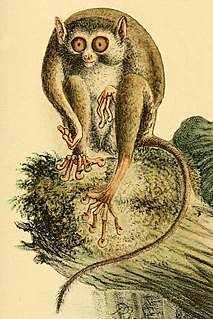 W
WThe Sangihe tarsier, also known as Sangihe Island tarsier, is a small primate found on Sangir Island, which is located about 200 kilometers north-east of the island of Sulawesi in Indonesia. In 2008 a population of the Sangihe tarsier was determined to be a distinct species, the Siau Island tarsier.
 W
WThe Siau Island tarsier is a species of tarsier from the tiny volcanic island of Siau.
 W
WThe Gursky’s spectral tarsier is a species of tarsier found in the island of Sulawesi in Indonesia. A recent taxonomic revision, split this species off from the spectral tarsier and other tarsier species based on difference in vocalisations and pelage.